
Emerging Technology: Processor Boundaries Breached
When we compare the microprocessors that are used on laptops and smartphones to the insanely fast core processors of desktops, the desktops would always sweep the competition. Apart from being somewhat more rapidly in comparison with microprocessors, the core processors can handle multi-tasking and heavily loaded applications that we run on our desktops.
But there is an emerging technology that will give a promising outcome of nearing the gap among micro and core processors. In a report of communications breakthrough, a team of scientists in the University of Pittsburgh claimed to a successful generation of a new frequency comb, which entails dividing a single color of light into a series of evenly spaced spectral lines for a variety of uses, that spans more than 100 terahertz (THz, or 1 trillion cycles per second) bandwidth (ZDNet).
Terahertz has never been reached and applied to any processors that we have on the …
Emerging Technology: Processor Boundaries Breached Read More

